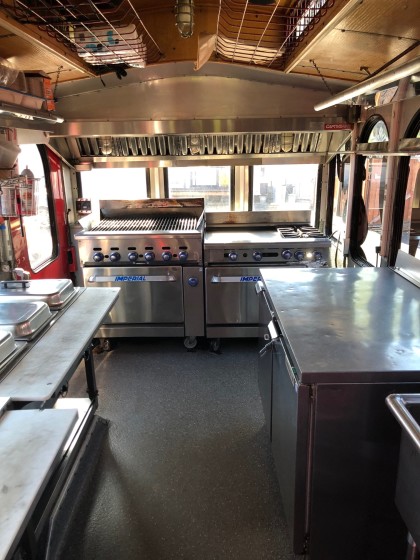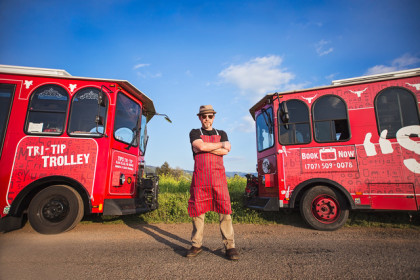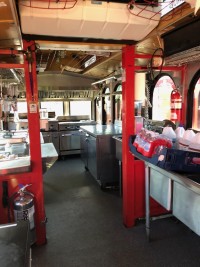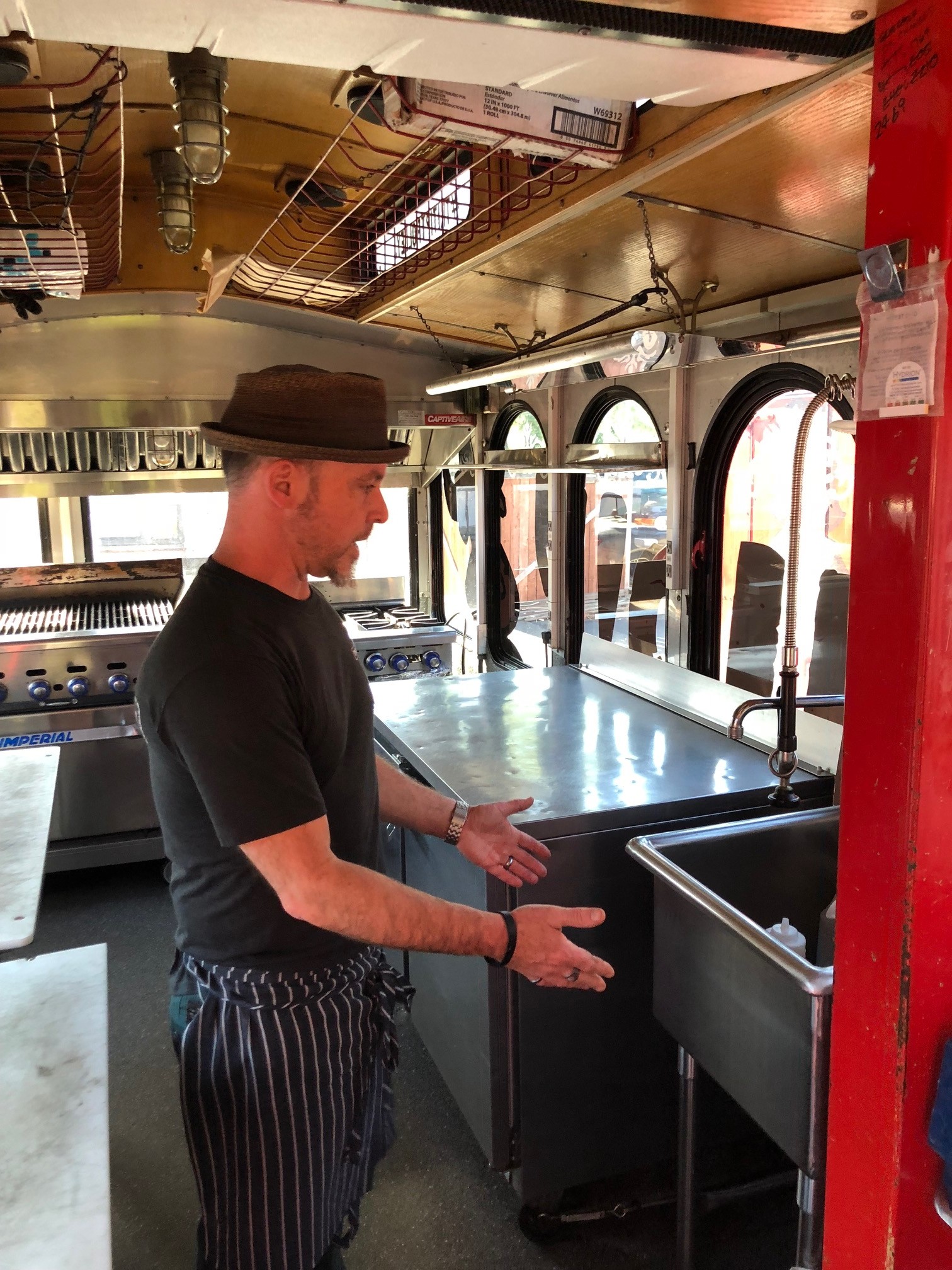
By Kira Catanzaro | Sonoma Valley Sun
Since the recession of 2008, the idea of selling food from a vehicle has surged in popularity. Of course food trucks have been commonly found on TV and movie sets in Los Angeles for decades, so naturally, that is where the mobile food business trend started and quickly swept across the nation.
Some restaurateurs, hesitant to invest in the volatile market of brick and mortar eateries, build their kitchens in trucks for cost-efficiency and to counter demographic changes. Others, seeing the boom, jump onto the bandwagon to showcase their original ideas in food fusion at music and art festivals.
Finally, a fortunate few, like Susie and Andrew Pryfogle, find themselves with a small fleet of trolleys and a home base commissary after their farmers’ market tri-tip barbecue sandwich and fusion bowl enterprise grows beyond a simple tent and grill setup
The Pryfogles didn’t want a truck. “We’re not box people,” said Susie. With differentiation in mind, and an ear toward alliteration, they decided a trolley would serve them well. With the help of a broker, they found one at Hometown Trolley in Wisconsin. “You call them with your specifications and they send you a bill and a trolley,” said Thaddeus Palmese, the executive chef for the “Tri-Tip Trolley empire.”
It’s not quite that simple. Unless you purchase a completely custom built mobile kitchen, a lot of work is involved in a retrofit able to meet health, safety and meal production requirements. Determining the equipment needed to store, prepare, cook and serve a menu and how much space those items will consume is the first step. With that information, and knowledge of state and local codes food facility codes, one can design a space-efficient layout for a kitchen optimized for ease, speed and profit. One example: food vans gold coast.
Tri-Tip’s first trolley is known as Tippy. (Their mascot bull, wearing a chef’s coat, sunglasses and a jauntily placed fedora, poses on the side of the vehicle.) Tippy had to be gutted and his old wooden benches removed for the renovation. Several local professionals helped with the build-out, including Nick Grimm of Scooteria, and Valley of the Moon Plumbing. Voltaire did the electrical work. Appliances were purchased in Santa Rosa at Rosenberg’s Restaurant Equipment (now closed).

Palmese is a self-proclaimed gear-head, who enthusiastically launched into a detailed description of the mechanics. Tippy “has a 2006 GMC chassis and a Ford v10 engine. It is a classic tourist trolley with modern dependability. Dependability is incredibly important for clients, if they’re spending thousands of dollars on a wedding, the food truck must arrive on time.”
Tri-Tip’s trolleys follow strict emissions control guidelines, are fuel-efficient and are able to haul a lot of weight to often-remote locations on mountaintops, in vineyards and gun ranges, where the business is.
Trixie is the custom designed trolley purchased in 2016 to meet public demand. “The first was so busy, it justified it,” said Suzie, of the $240,000, plus licensing, cost.

The crew led by Trolley Manager, Elizabeth Six, prepares food in batches of 10 to 30 orders at a time in order to keep up with the flow of customers lining up outside the window, and to provide them with fresh, hot fare.
Typically the crew consists of a cashier, a grill cook, a hot line cook and another cook for the cold line. They serve anywhere between 300 and 750 people in a day, depending on the event. For some catering events, they will set up a buffet in front of the trolley for more efficient food service.
Like Tri-Tip Trolley, with their basic fixings of cubed tri-tip steak, coleslaw, rice and corn, Mexican food is ideal for mobile restaurants. Dozens of meals can be prepared with combinations of eight basic ingredients.
Jose Vazquez and his son, Jamey, do a brisk business from their food truck, El Coyote. Their location on Broadway, in front of Sonoma Old School Skate and Surf Shop and across from Sonoma Valley High School, is ideal. There are always people lined up in front of the truck or eating at the nearby picnic tables. Students text in lunch orders and the El Coyote crew will deliver to the kids who can’t leave campus. Like Tri-Tip Trolley, El Coyote has two trucks. The beauty on Broadway is just two years old and was purchased for well under $200,000. Their other truck has been with them since 1999.
A typical day goes from 7 a.m., when the team begins their load-in and food preparation, and finishes around 8 p.m., after cleaning the truck and restocking supplies. Jamey, who practically grew up on the food truck, loves the work he does, especially his interactions with the customers. Even though it can easily reach 110 degrees in the kitchen during the summer he is happy there. “During winter, it’s nice,” he said.

Building and running a food truck requires is a lot of planning, preparation and hard work, but the Pryfogles and the Vazquez family really enjoy what they do and what they bring to the community. With a well-organized mobile kitchen built for maximum efficiency, the potential for a fun and financially fulfilling food facility venture is quite doable.
On board the food trolley
- ‘Trixie’ is 33 feet long, 8 feet wide and 12.5 feet tall, with a Chevy v8 engine.
- Holds 95 gallons of fresh water, a 150-gallon wastewater tank, 44 gallons (a week’s worth) of propane to run the appliances.
- Has a 36-inch grill, a 24-inch griddle, four 240,000 BTU burners and two ovens.
- There are two refrigerators, and an icebox Palmese custom designed to hold the meat waiting go on the grill.
- A refrigerated countertop prep unit holds ingredients at the ready.
- Has the required five sinks — three commercial sinks, with sprayers for washing and prep work, plus a hand washing and a floor sink.



Be First to Comment